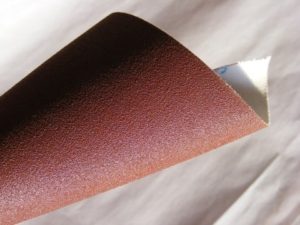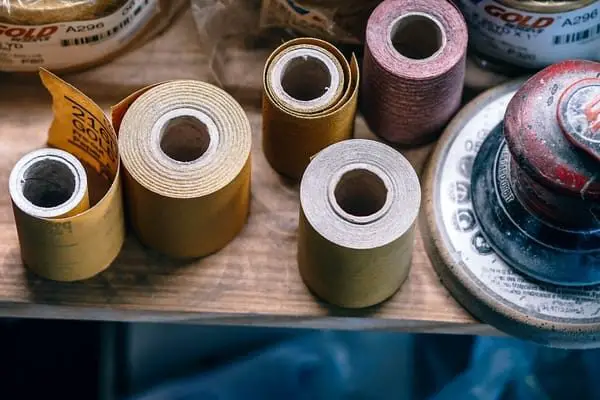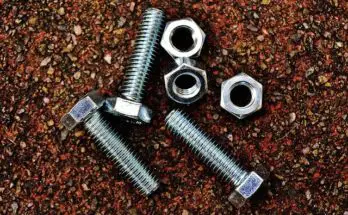Sandpaper is something we have all touched or used at some point in our lives. If it’s not something you’ve used often, you may wonder what the different grits are and what determines which type of sandpaper you should use for your specific project. We will cover these points below.
Sandpaper is described as an abrasive that is used to smooth or change the surface of an object. Most often, sandpaper is used in woodworking and metalworking to smooth the surface of an object.
In fact, you may not realize it, but when you take your wedding ring to a jeweler to get sized, they use sandpaper on your ring to smooth the seams created when they cut the metal to either enlarge or reduce your ring size! Many people don’t realize that something as fragile and expensive and a wedding ring can have sandpaper applied to it without damaging it.
History
The earliest records of sandpaper being used is in China in the 1st Century. The Chinese realized they could smooth a surface by crushing the shells of various nuts and rubbing it on the surface of an object. Over time, other materials were tested and used. Some of these other materials include rocks, gemstones and even glass. The first company to develop a type of sandpaper that could be mass produced and used by the public was 3M in the early 1920’s. Their initial paper production was used within the automotive industry as the use of mass production assembly lines were growing in popularity in Detroit.
What is Sandpaper made of?
The material used to create sandpaper has changed considerably over time since what was used in the 1st Century by the Chinese. Today, most sandpaper is made from silicon carbide, aluminum oxide and garnet. These materials are then attached to paper used a strong adhesive that can withstand the paper being rubbed against an object.
Grit Explained
Sandpaper grit actually has very little to do with the paper itself. Instead, the grit is determined at the time it was created. Prior to the aluminum oxide or other materials being applied to the paper, the particles are sifted thru a screening process. The largest screen that these particles pass through determines it’s grit. For instance, the particles on a 60 grit piece of sandpaper were passed through a screen that had 60 holes per square inch. Therefore, the particles on higher grit sandpapers had to pass thru much smaller screens.

The lower the grit number that you see on the back of the paper, the more course or rough it will feel which in turn removes more material with each pass. If you run your hand over a high grit paper, you’ll find it is much smooth, but this removes less material and makes very small abrasions into the wood with each pass.
For instance, using a 60 grit piece of sandpaper on a piece of wood will quickly begin removing material from a piece of wood. The material being removed can be anything that’s been applied to the wood, such as a paint or stain, to removing layers of the wood itself.
Now, using a sandpaper with a much higher grit will achieve very different results. If you use a 300 grit piece of paper on a board, you will notice very small changes in the wood as you rub it. That’s because the paper has much less cutting capability which requires many more passes in order to achieve the same results as that of the 60 grit paper in our example.
Using the correct grit can save yourself a significant amount of time, energy and frustration!
Which Grit do you need?
The end result of what you are wanting to accomplish will dictate what sandpaper grit you should use on your project. Below is a table that will help you determine which sandpaper grit you should choose for your particular woodworking project.
Action Needed | Suggested Grit | Details |
Remove paint, glue, etc | 60 or 80 | Use this if you are wanting to repaint a piece that is already painting. Sanding it with a course grit will remove the old paint and ensure a smooth and consistent paint mixture |
Surfacing Smoothing | 100 or 150 | Use these to change the surface of your workpiece. These are helpful at sanding a surface down to remove a blemish in a piece of wood such as a scratch and dent. |
Final Finishing | 180, 240, 320 | These are used to prep the wood just before staining or finishing. Since the grit is very smooth, it will remove and sandpaper marks left by other lower grits that you’ve already used. |
| Final Sanding | 400, 500, 600 | These are used less commonly, however, when they are used, it is the final steps before finishing. These are used to remove all scratches from previous sanding for an ultra smooth finish. |
Uses of sandpaper
Sandpaper actually has more uses than just removing old paint or repairing the surface of a piece of wood. There are actually times when you will want to use a sandpaper to roughen up a surface prior to a applying certain finishes. One example is during the application of a clear coat or polyeurthane. Many people find that by sanding with a high grit paper between staining applications that their stain adheres to their project much better.
As vintage and weathered home décor has become more and more popular, so has the use of sandpaper. However, rather than being used to make a piece look smoother and even, it’s used to make the piece look as if the paint was applied several decades before. Using a high grit sandpaper on a painted wooden piece will remove a small amount of paint based on how hard you press down. This adds a vintage feel to the piece.
 Tip! Here’s a technique that can provide a unique finish – Take a piece of wood and apply a based coat of paint. Once it has dried, apply an additional coat of paint that is a contrasting color. Once both applications have dried, lightly sanded a section of the wood. This will begin to remove the top layer of paint which will reveal the first color that you applied. Continue rubbing and you’ll reach the actual wood. You can add as many layers of paint as you like. It creates a very unique look with unlimited options available.
Tip! Here’s a technique that can provide a unique finish – Take a piece of wood and apply a based coat of paint. Once it has dried, apply an additional coat of paint that is a contrasting color. Once both applications have dried, lightly sanded a section of the wood. This will begin to remove the top layer of paint which will reveal the first color that you applied. Continue rubbing and you’ll reach the actual wood. You can add as many layers of paint as you like. It creates a very unique look with unlimited options available.




